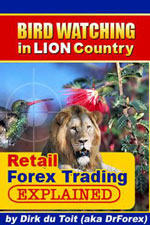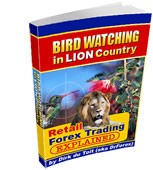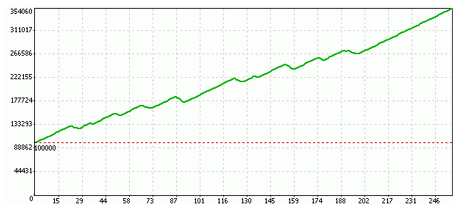
I still purchase some e-books these days, mostly a hangover from my early days in an attempt to find some new insights or terrific system or perhaps simply curiosity.
When thinking about reviewing the book Bird Watching in Lion Country I realized how difficult it is to write an objective, fair and substantiated book review. After a while I gave up on the "objective, fair and substantiated" bit and decided to just write down some random thoughts and hopefully they are of some assistance.
Bird Watching in Lion Country is a top selling forex course written by Dirk du Toit aka Dr. Forex, it covers all aspects to become a successful currency trader. Included is his popular 4x1 strategy to make money forex trading. Currently Dr. Forex is busy automating his 4x1 median trading strategy. The forex market is 'lion country'. Bird watching in lion country can be a very rewarding, yet dangerous experience.
Trend/median trading is a succinct description of his system. Dirk du Toit is fundamentally against highly geared trading - standard 100:1 accounts are a big no no - and don't even think about 400:1. He's good on both trade and risk management. So you won't lose your shirt - but neither are you likely to compound your pot in the other direction with undue speed either.
Basically on a 1 hour chart with around a months data draw in major support and resistance around 300-400 pips apart, and then a range in the centre of that (the median). His theory is that the price will revert to the median with time and uses this to time trades. He recommends low gearing, which allows large stops and only taking entries in the direction of the trend. It's a 200 page book so there is obviously more to it than that, but it is a quite simple less stressful system.
Dirk doesn't have a tip service. However, if you follow his program you will gravitate towards the same approach to the market that he has and intuitively understand how the shared "fundamental" insights may effect your positions or how you should think about new positions. Dirk does not call it "fundamentals", but "market dynamics" - and it is all about getting in tune with how the market discounts, which is IMPORTANT (and stuff the rest) information and how that shows up in prices.
Taking the risk that I stand to be corrected by the Doc himself, I would say he is an (not very strict) intra week trader. But that doesn't mean you can't be a very successful intra day median trader. He believes in taking profits regularly off the table and there is no sin in taking a 30 - 40 pip profit, however a 100 pointer is also welcome and necessary from time to time, thank you. In his new book, "Bird Watching in Lion Country", he very convincingly argues that strict intra day trading is a basically random effort and most won't ever be successful with it. Realizing this his mentoring is geared towards helping one to see that a "manageable time frame", which can differ from individual to individual, is much more suitable.
The most important aspect I think where his approach differs from every other retail forex trainer that I have come across (except the real empathy and real concern inherent to his personal approach) is his MULTI ENTRY system. In other words, where most say, take the maximum you are prepared to trade with, wait for your signal, add your stop and limit and trade, he says, "just take a little bit of what you are prepared to risk and enter in a identified "zone", and then add to that position, preferably at BETTER prices (not more expensive) and do so until you are fully "invested" and then wait for the profits, which you can pick off all at once or one by one."
One can easily scan the chapter headings in the contents page and think these are topics you know well, or have already read about many times before. Except maybe for Part 4, so you skip over Parts 1 - 3 directly to Part 4 to get the secret formula. This would be a mistake - take your time and read the book from page 1 to 238 because it really explains the forex landscape (lion country) in a unique way.
No matter what kind of a trader you are and what indicators are dear to your heart, read the book with an open mind. If your trading is not going all that great, take a week or 2 off while you read the book - you may just come back with some new and fresh ideas. You may even continue scalping if that is what you really enjoy, but with a different mind-set.
With regard to specifics like entry and exit signals, and trade (and risk) management - Bird Watching in Lion Country turns a few "truths" upside down and offers a different perspective. Surely timing of entry has to be pin-point (or pip-point) ... really? Surely you should cut losses short and let profits run...or should you? Surely you should never add to a losing trade...or should you? Get out as soon as you think you are wrong...or not?
But don't skip Parts 1 - 3 just to get to Part 4! ![]()

Part 1 is very general, but specific and enticing enough to compel the reader to fork out the money to buy the balance of the book.
Part 2 is about the psychological attitude toward the market, the statistical approach and the edge. This part sets the real deep down fundamentals of how you can become a winning trader. Dirk makes the point somewhere, probably in this Part or maybe Part 1 that winners and losers are not divided years or months (most self-traders are simply too "short sighted" to think in terms of years) down the line, but on day # 1. You need an edge. The edge is not the result of the system, but the beginning. This part also contains some other necessary mumbo jumbo, trading psychology type stuff beginners and losers need to hear and will adhere to hopefully now that they read it in the proper context.
Part 3 is about how the FX Market works and underlying fundamentals. Dirk explains why the characteristics of the FX market that all the market makers put up on their websites are vitally important and why you should not dismiss it as "useless information". He also explains practical aspects which will confront you and which can be used to your detriment or used to contribute to your success. The concept of overshooting, trading data releases, the 24 hour day. All of this must be included in your approach. He specifically shows how the "marketing wizards" like the sponsors of some well know forex portals have a grip on the general informational spam in the retail FX industry, which they use to get people to dump margin in their "segregated" bank account and then systematically turn it over to their "profit account", thinking they are going to become market wizards ... ![]()
"If an experienced person meets a fool with money, soon the experienced person will have the money and the fool the experience"
Part 4 is the system. I think that the "technical" part of the system is interesting and good. The fact that there is not a detailed method with accurate numbers is fine with me because at least you get the general idea and you can yourself deal with the details. The whole system is based on the fact that you have an edge because your trade in the way of the fundamental trend. The big issue is how do we determine clearly the fundamental trend, because if we are trading in the wrong way that could be pretty bad. And in my opinion the book presents that finding the long term fundamental trend is almost obvious. We have hints like differences in interest rates or other basic fundamental indicators but what we can do with a bunch of contradictory news that are coming every day, and what is the relative importance of each of them we don't know. This part contains a section about looking at this idea to trade your own money strictly from a business perspective and also then contains his 4 X 1 trading strategy and median trading methodology. And relational analysis - relating price, time, events.
Experienced traders will after reading the book probably add something to their armoury or may revamp their trading completely. New and inexperienced traders will have a refreshing and sensible look on the market and they will have the basics to make it work. But a book is a book. Trading systems are not bought of the shelf, installed in your brain and the money dropped into your bank account ![]() .
.
I had also the feeling of contradictory statements for example (but it's not the only one) between the fact that market is a dangerous lion but it has a statistical behaviour (is coin flipping threatening?). Otherwise the fact that the mentoring program is highly promoted is not such a problem because it is mentioned more only at the very beginning and the very end, so you can easily avoid the commercials. The fact that the system is not accurately defined is OK but the problem is more that the author states that you will get to know everything in detail and that is not true.
So, I would say that the book had some very interesting parts but seems to have also some "holes".
Some backtest results using the 4x1 strategy and the method described in Part 4 of his course.

Dirk du Toit calls his analysis technique 'relational analysis' or 'real time analysis'. It is about relating price (and price changes); time (the time it take the price to change and the time of considering any price); and events (any factors that may influence prices in the time frame I look at the market). In other words, what most people call fundamental analysis (i.e. the fundamentals behind price changes) is an important aspect of what Dirk incorporates in trade decision-making.
However, Dirk du Toit calls himself a technical trader because he uses technical parameters of recent and historical price changes and technical price levels to make trading decisions (in conjunction with the above). Most indicators only serve to confuse the issues. In a clean price chart there is too much in formation to use sensibly. Dirk adds that the moment you add all sorts of indicator lines...etc you just add to the confusion/overload of information. You should not add to information Dirk believes, but distill the USEFUL information and work with that fundamental type, information, or what he calls market dynamics which are VERY useful to filter out the overload contained in price charts suffering under the load of subjective technical indicators off all sorts.
The only way you are going to make extraordinary returns in FX is with high leverage. But high leverage can be a big problem. It starts pretty soon to affect the way you trade. For instance where you place stops to take losses. If you make a loss you have to make it up before you can think of moving ahead. Dirk's view is simple: if you are short term orientated in your expectations you will be around for a short term. It makes much more sense to make sure you can trade on a small amount and make relative good returns in percentage terms to one day if you have the means trade properly than to be fooled by randomness and misread your luck for skill and then later just lose a large amount when your luck turn.
Stop losses are definitely one of those things that will depend on the risk tolerance of the individual. Dirk's method is to try and hold trades through some severe dips, so that you give the market time to allow the long term trend to re-establish itself and return your trades to profit. Obviously, this will not happen all the time, and the market can remain in a retracement or correction for longer than you can remain solvent. It is up to the individual trader to ascertain their own cut off point.
Dirk only buys the EURUSD because that is the direction that the longer term trend is going in. You give yourself an edge by just playing the long term direction. Corrections and retracements against the long term trend are hard to time and even harder to predict how far they will go. You can save yourself a lot of worry and stress by keeping things as simple as possible while at the same time making your edge as strong as possible.
Dirk du Toit speaks of having two guidelines on when to cut his losses. If a trade is 150 pips in the red then Dirk will consider hedging the trade at that point. Sometimes he'll do this, sometimes he won't (generally because he likes to keep things simple and hedging can act an extra layer of complication). If things progress to 200 pips in the red then he will seriously start to look at the possibility that the dollar strength will continue. If the dollar bulls have the market on the run then he has no problem in exiting my position for a loss. This generally means that trades entered in Q4 are under scrutiny in Q2, and Q3 trades in Q1.
The second main guideline is when the bottom of the grid is being tested. If the bottom of the grid is breached by price and the breach continues then obviously the grid is no longer really valid and needs to be readjusted. In this case, all open trades need to examined and closed out if they no longer make sense given the new grid placement.
A market going the wrong direction is giving opportunities to average your cost of buying and that is the secret in the approach. Multiple cost averaged entries add to the total leverage and that means that by the time the market is ready and turn around you are in the market with a nice position and then you make good money. This is way beter than jumping in and out and round and about with high leveraged short stop hit you here knock you there tactics which is the exact way the majority of losers trade. And it gets them nowhere.
To illustrate this from a reverse perspective, how many times has a trade been closed (and therefore a REAL loss realised), only to find price reverse shortly thereafter to find that the loss could have been reduced or turned into a profit? Dirk's point is that once a stop is activated, then a REAL loss is realised i.e. the money from that trade is gone, for ever, and nothing will get it back. The only thing that will offset this permanent loss is a greater gain than the loss, from a new trade that is statistically totally independant of the losing trade.
Bottom line - once a trade hits a stop, a permanent loss is realised. Let me say that again - when a losing position is closed, the loss is finalised. Until then, there's always potential to break even or turn a profit. Dirk says that if he's wrong on the macro-direction, he'd rather make this loss on a small position than a large one. Of course the position could be an increasing loser, but he has held positions for two years before coming out on top, at no cost to him. Same goes for holding real estate until a market recovers.
Given all of the above, losing trades are obviously going to be much larger than the daily small profits of a winning trades. That is one of the main reasons of looking to have occasional 100+ pip profitable trades resulting from Q1 or Q2 entries. These large trades will be the main counterbalance to the occasional large losing trades. The daily small profitable trades that you grind out then become the trades that allow your trade balance to slowly rise over time.
Is the book a trading system? Does it reveal a trading strategy? If you refer by strategy to -: 'buy when x crosses y and the RSI is above 55", then no.' It is a way to look at the markets, look at prices, get an understanding of what price action over the long term is doing. Then put a framework around that, which gives you a way to trade.
It appears to me that the very best books--those that get recommended by a wide range of traders--never include set strategies. They teach you to think like a trader and not just copy one who may or may not have been successful at some point in time.
I find this analogous to cook books versus recipe books. A recipe book will simply show you how to copy someone else's work. But given all the variables, the result may or may not be satisfying. A cook book teaches you how use food to make your own creations and even write your own recipes, then, with confidence, modify them as your taste and needs change.
In my mind, the book 'Bird Watching in Lion Country' stands out as an eye-opener in a sea of dreadfully mediocre (or worse), cookbook-style forex trading books out there. You may or may not end up using some or all of his particular methodology... it's not mechanical and requires a fair amount of discretion/judgment. Most important, it calls for a paradigm shift that many traders would probably be unwilling or unable to make. Even if you decide not to use his methodology in its entirety, I think the knowledge gained will be invaluable.
I know many readers here are scared to act, because there are so many scamsters out there. For their sake I can mention:
I have been to South Africa (Pretoria) and have visited Dirk at his house where he works from, and he is for real. He lives in a pretty smart, nicely furnished, house with a beautiful view in an affluent suburb of Pretoria, with newish (but not latest) model BMW and Merc in the garage, and he trades full time since 1998. So I believe, considering that he does not get $10 brokerage on each trade 5 times a day, (cause his clients mostly trade 10K lots, and not even once a day), do not charge $5,000 for training etc. he obviously has something going for him - and I don't think it is a big inheritance.
Flashback Points to Note and Recall About the book Bird Watching in Lion Country:
Dirk du Toit is based in Pretoria, South Africa where he heads DayForex Capital Management, which specialises in the forex investment market. DayForex focuses on the trading of forex investments on behalf of clients and mentoring of self-directed forex traders.

After qualifying with an M.A. degree from the University of Pretoria, Dirk joined the financial services industry as an advisor in 1991. In 1998, as a primary source of income, he started trading on his own account in the global financial markets. His areas of focus were bonds traded on margin, equities and, since the advent of retail forex, currencies.
Since the beginning of 2001 Dirk has focused mainly on sharing his trading acumen with prospective self-directed traders interested in the forex market, while preparing the groundwork for DayForex Capital Management - these days a discretionary forex services provider fully authorised by the South African financial authorities.
Dirk du Toit is the Chairman of the Forex Investment Association in South Africa and an Associate of the Financial Planning Institute. He also holds the International Capital Markets Qualification from the Securities Institute in London.
Dirk has written two e-books on foreign exchange: "An Introduction to the Foreign Exchange Market", and "Bird Watching in Lion Country - Retail Forex Explained" - a 'must have' book for anyone trading or intending to trade in the forex market.
Please do not copy/paste this content without permission. If you want to use any of it on your website contact us via email at ![]() traderATfinancial-spread-betting.com (remove the AT and substitute by @).
traderATfinancial-spread-betting.com (remove the AT and substitute by @).